Baader Narrowband Imaging Filters
Main Purpose: Capturing colour data in Deep Sky objects
|
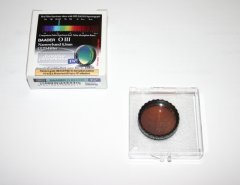
|
With the use of these special filters the light from specific wavelengths of light can be captured. They are used to capture the light emitted by certain types of ionised gases present in deep sky objects (primarily nebulae). Because the filters allow only a narrow band of wavelengths (centred on the frequency specific to the emission) they show the nebula at high contrast. These wavelengths of light are known as emission lines, because the frequency of the emission can be represented as a line on a spectrum diagram.
|
- Hydrogen Alpha represents the red light with a wavelength of 656.281 nanometers that is emitted by an electron transitioning from energy level 3 (ie. 3rd from the nucleus) to level 2. The Baader filter (Click HERE for information in German) has a fairly narrow bandwidth of 7nm
- Hydrogen Beta represents the light emitted as a result of the transition from level 4 to 2. I don't have a filter for H-Beta, whose light is towards the blue end of the spectrum, and has a wavelength of 486 nm.
- Doubly ionized oxygen (known as [O-III]) emits green light at a wavelength of 500.7nm and 495.5nm. The [O-III] line is known as a Forbidden Line because emission does not occur under normal (terrestrial) circumstances. It can however occur in the low-density conditions of nebulae in outer space. Because of this "forbidden" nature, the name has the square brackets, as in [O III]. The The Baader filter has a bandwidth of 8.5nm.
The separate images from these so-called "narrowband" filters, can be combined as if they were images from standard red/green/blue filters to produce artificial RGB (or LRGB) images in false colour.
Click the image, or HERE to see more details.
|
|
|
|
| to top |
home |
|
Astronomik L-RGB Imaging Filters
Main Purpose: Capturing luminance and colour data with black-and-white camera
|
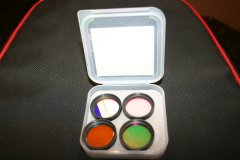
|
The filters shown in here replace the coloured observing filters below for capturing colour images with a black-and-white camera. They are better for that purpose than the observing filters because they are designed for that purpose, the set of three having the right band-width in each colour to properly and accurately record the intended colours. The filters all block infra-red too, which is important for colour imaging filters.
The "L" filter is a simple IR-blocker, which will be used to capture a "luminance" image. This is a simply a black and white image that can be used as a brightness layer.
|
|
|
|
| to top |
home |
|
Coloured Observing Filters
Main Purpose: Enhancing contrast when viewing planets
Secondary Purpose: Capturing colour data with black-and-white camera
|
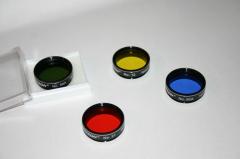
|
These filters are intended for visual observing. They come in a number if different colours, each giving a different effect when added to an eyepiece. The colours are standardised and identified using a set of "Wratten" numbers. For example the Orange filter in the picture here is number 21. Using coloured filters improves the contrast on planets so you can see certain features better, for instance the cloud bands on Saturn, Jupiter's red spot, or albedo features on Mars.
|
|
They can also be used as a cheap way of gathering colour data with a black and white camera. I have done this using a Red (wratten #25), Green (#56), and Blue (#38A) filter with my SC3 webcam. It is important to remember that because these filters are intended for visual observing they don't block infra red light so an additional IR blocking filter must be used at the same time for proper colour rendition.
|
|
|
|
| to top |
home |
|
Baader UV-IR blocker
Main Purpose: Lunar/Planetary imaging
Secondary Purpose: Blocking IR when imaging with plain R/G/B filters
|
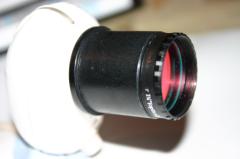
|
This filter is used to remove the IR component from stars and reflected from planets. CCD sensors as used in astronomical cameras and webcams are very sensitive to Infra Red light which therefore will affect the colour of the image you are capturing. The IR blocking filter will prevent this. Another reason is that when imaging through a refracting telescope the IR light, like the blue, will be focussed at a different point than the other light. This can cause star bloat and out of focus images. The filter is shown here attached to my ToUCam Pro webcam.
|
|
It isn't always necessary to use an IR blocker, even if your webcam has had its own filter removed. Many people find that some planets are imaged better with a filter and others without. Saturn in particular is mentioned as one that, due to its relatively low brightness, can benefit from being captured without the filter. The IR light will add to the overall light captured and allow a lower gain setting -- meaning a lower noise image.
|
|
|
|
| to top |
home |
|
Home-made IR-pass filter
Main Purpose: Infra-red channel on the Moon or Mars
|

|
An infra-red pass filter allows images to be captured using only the infra-red light emitted or reflected from an object. This kind of image can be very useful for capturing detail on the Moon or Mars.
An effective filter can be made using 2 layers of exposed photographic film. I cut two discs of this material and mounted it in a holder taken from an unwanted colour filter. Click the image or here to see how I did it.
|
|
|
|
| to top |
home |
|
Astronomik CLS filter
Main Purpose: Removing light pollution when deep Sky imaging
|

|
This filter passes most light except specific frequencies that can interfere with the light from galaxies, nebulae, and other deep-sky objects. This means that fainter objects can be photographed and longer exposures captured without the image getting overwhelmed by the sky glow. I have found this filter particularly effective on red emission nebulae like the North America nebula and the Rosette Nebula.
|
|
The filter box is shown here because the actuall filter is closed up inside my filter wheel (see below)! It looks similar to the other filters shown here but the surface looks rather mirror-like.
|
|
|
|
| to top |
home |
|
Baader Contrast Booster filter
Main Purpose: Eliminating Chromatic Abberation with a refractor
|

|
Refractor telscopes come in two main types: Achromatic, which are cheap, and Apochromatic, which are expensive. The difference is that unlike the expensive "apos", an achromatic lens cannot focus all wavelengths of light in the same spot at the same time. The effect of this is that bright objects have a blue or violet fringe along their edges and brighter stars have blue rings around them. The solution, apart from an Apochromatic telscope, is to use a "minus violet" filter that removes that part of the light that causes the blue fringes. The Baader contrast booster is a similar filter made of a special Neodymium glass with coatings that combine to completely remove this false colour, and some sky glow too.
|
|
|
|
| to top |
home |
|
Atik Filter Wheel
Main Purpose: Tri-colour imaging with black-and-white camera
|
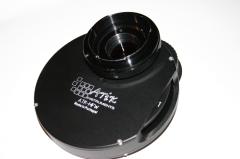
|
My Vesta SC3 modified webcam has a replacement CCD image sensor that does not have a colour filter matrix, making it more sensitive. However that also means that it can only be used to capture black and white images. To capture coloured images filters must be used. For full colour images, separate red, green, and blue frames are required and the filter wheel makes it easy to change filters without removing the camera from the telescope.
It is also a convenient way of using filters with my Canon EOS300D camera. The filter wheel is shown here with a Canon T-adapter attached.
|
|
|
|
| to top |
home |
|
 |
|
All text and images copyright and may not be used without permission
|
